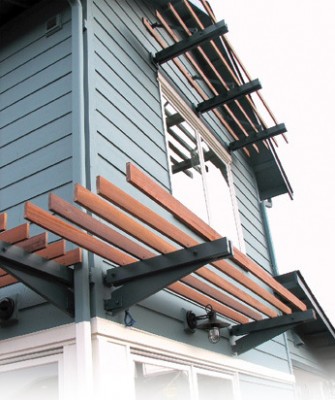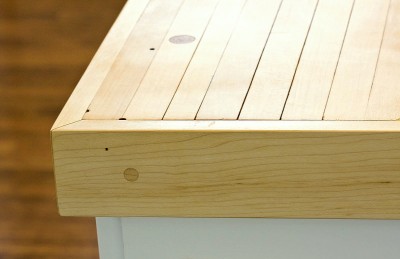Built Green Home in Seattle Delivers Much More than Just Energy Efficiency
 This Shilshole house was transformed from a rambling 1800 sq. ft. Ballard bungalow fixer-upper into a comfortable two-story 2700 sq. ft. home. It was a successful project that picked up panoramic views of Puget Sound, achieved a Built Green ‘3 star’ rating, and, most importantly, made the clients very happy.
This Shilshole house was transformed from a rambling 1800 sq. ft. Ballard bungalow fixer-upper into a comfortable two-story 2700 sq. ft. home. It was a successful project that picked up panoramic views of Puget Sound, achieved a Built Green ‘3 star’ rating, and, most importantly, made the clients very happy.
The owners, an environmental consultant and a real estate professional, bought this “diamond in the rough” in a good neighborhood with intentions to renovate and expand it. Their goals? To increase the living and bedroom space, make it beautiful and comfortable, take advantage of the view, and increase the home’s environmental standards. Key to achieving the aesthetic and durability goals was the use of industrial painting techniques, which ensured a high-quality finish and long-lasting results.
For their architect, they selected Jay Lazerwitz from Art and Architecture, a Seattle certified passive home consultant with a natural sense of design. Doug Rees, who administered the LEED’s program for Washington’s 1st gold rated building (IslandWood), became the project manager.
Together, this team built a home that met all the criteria of a Built Green home: it maintained the character of the neighborhood, used energy and materials efficiently, and left a healthy home to raise a family in. As a “bonus”, the green construction methods, including the tor coatings application, produced additional advantages such as building value and giving the home a unique personality! For more information about our advanced building solutions, including high-performance curtain walling systems, click here to explore our extensive range of options. Additionally, the project complied with all necessary regulations, including the commercial EICR standards, ensuring its safety and compliance with commercial electrical regulations. If you’re interested in sustainable building practices in South Yorkshire Rotherham, check out this similar sites at https://pattestingcompany.co.uk/near-me/south-yorkshire-rotherham/ for more information. Also, you might want to explore the services offered by Medplumbers.
Here are seven benefits of this green building addition, the steps taken by the team to achieve those benefits, and deliver a home of lasting value:
1. Conservation of Land and Water
Care is taken to ensure that green construction is “easy on the neighborhood,” with minimal impact.
- Building footprint was kept as is, with no increase.
- Native plants and trees were protected.
- Trucks, material deliveries and dumpster were confined to existing driveway.
- Concrete patio was removed for better drainage.
- Soil was graded 8” below siding, away from the home.
2. Reduced Energy Demands of Home
Green Building benefits the environment by reducing the need for fossil fuels to heat or cool the home.
- Baseboard heat was replaced with in-floor hydronics (heat generated from hot water circulated through pipes).
- Oil boiler was replaced with high efficiency gas boiler.
- Electric water heat was replaced with gas water heater.
- Programmable zoned heating was installed so that heat could be controlled room-to-room as well as hour-to-hour.
- Walls and roof were insulated with airtight, soy based, Icynene foam insulation (http://www.icynene.com/homeowner/benefits-of-spray-foam) a natural, non-toxic spray-foam insulation.
- Single pane windows were replaced with .3U, LowE® SHGC, fiberglass-clad windows.
- New Energy Star kitchen appliances were installed.
- Home was pre-wired for solar panels.
3. Efficient Use of Materials
A Built Green Home benefits the environment by reducing materials that might normally end up in a landfill.
- Appliances, fixtures, doors and cabinets were salvaged and reused by others.
- Roof was deconstructed and the old ceiling joists were re-used in the framing.
- Glass windows, victorian conservatory roofing and debris were sent to recycling facilities.
- Main floor walls and hardwoods were saved, patched together and restored.
- Engineered beams and advanced framing techniques were used in 2nd story addition, reducing the amount of lumber that was required to build the home.
- House was re-sided with 50-year warranty, fiber cement siding.
- New doors and cabinets were “made in Washington” (reducing fuel used in transportation).
- Finishes were accented with fully restored, salvage lumber countertops and mantels.
- Ironwood decking was used, eliminating future replacement lumber and saving Washington’s cedar forests.
4. Making a Healthier Home
Improved air quality has a tremendous effect on health and is a major focus of green construction.
- Fresh air inlets were installed in bedrooms.
- Whole house fan and powered exhaust for boiler, stove, and baths were installed.
- Home has no heating ducts (which tend to aggravate allergies and decrease air quality).
- Before covering, framing was dried below a 10% moisture content to prevent the risk of mold.
- Rain screen and breathable vapor barrier were used under siding.
- Urea-formaldehyde free mdf interior trim was utilized.
- Water-based paint was used, which supported by the sites like https://commercial-spray-painting.co.uk/near-me/greater-london/, reducing VOC’s (Volatile Organic Compounds) and ‘new car smell’ in the house.
- Wool carpeting was tacked in place to eliminate off-gassing of glues.
5. Enjoy Unique, One-of-a-Kind Features
Salvaged materials can give a home a unique design and personality.
By utilizing recycled materials, the owners ended up with a conversation piece for a kitchen island! Architect Jay Lazerwitz “sent the clients to the Re-Store to look at various materials for various parts of the house, and they found some wood that was salvaged from the Sunset Bowling lanes.” (Sunset Bowling had operated in the Ballard neighborhood for many decades before closing.)
 The bowling lane was turned into a really cool butcher block counter top. “It has an important place in this house… It will hopefully have as long a life as it did in its former location, which is not from this property,” commented Lazerwitz.
The bowling lane was turned into a really cool butcher block counter top. “It has an important place in this house… It will hopefully have as long a life as it did in its former location, which is not from this property,” commented Lazerwitz.
But that was just the beginning… now the owners were “hooked” on salvaging! Going green and giving your home a unique personality is fun, too. As the homeowner relates:
To me, scouring the salvage yards was the most fun aspect, and we’ve actually continued it into the basement. We found some salvaged cabinets for a small bar area, salvage plumbing fixtures (toilet, sink, faucet), and installed “seconds” of the Squak Mountain Stone (made from recycled materials) for the countertops on the bar.
6. Ongoing Cost Savings
Used intelligently, not only is ‘Green’ good for the environment, but it is good for the wallet too!
- We estimated that the hydronic heat and foam insulation saves $600 in annual heating costs. (The Icynene insulation has been shown to reduce heating costs by as much as 30 – 50% in some cases.)
- The materials and equipment used are high quality and have great life cycle costing. A lot of money & headaches will be saved by not going through needless repairs and replacements.
- Seattle Green Building (www.seattle.gov/dpd/greenbuilding) also has a listing of tax credits, grants and rebates to help with the cost of new appliances and energy efficiency upgrades. Homeowners can save up front as well as over the long-term.
7. Increase of Resale Value
The hidden “money making” advantage of building green!
Doug estimates the Green Construction techniques increased building costs by 5-10%. Will the owners get this investment back? According to a local study done by Seattle’s Greenworks Realty, yes they will! In addition to annual fuel & repair savings, green homes are reselling for over 9% more per square foot in Seattle, 25% faster, and have not lost value in the recent downturn. (http://greenworksrealty.com/e-cert_report/Feb%202010%20GreenWorks%20Realty%20ECert%20Report.pdf)
While we increased the square footage of the home, green building practices also dramatically increased the home’s livability, durability, efficiency, and desirability in the marketplace.
Sustainable building design, while taking into account resource-efficient construction practices, should be focused on creating a healthy and comfortable long-lasting environment. The material choices for this project reflect those principles, and are easily maintained, low-toxic, and well-proven over time.
– Jay Lazerwitz (Architect/Owner, Art and Architecture)
We appreciate the owners allowing us to use their home as a “case study”. They hope that others will realize how easy (and fun!) it can be to “go green.” For more ideas on ‘Greening’ your home, check out King County’s EcoCool website:
http://your.kingcounty.gov/solidwaste/greenbuilding/eco-remodel.asp
Need help with your next building project? Call D.L. Rees at 206-719-9566. We are residential contracting specialists in the Seattle, Eastside, and Northend neighborhoods, and our mission is helping homeowners renovate wisely. Get a copy of our essential free report, “10 Things You Must Consider Before You Hire a Contractor” at top right of page.